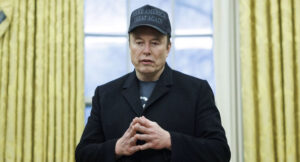The frenzy over Chinese artificial intelligence is turning Alibaba Group Holding Ltd. into an investor favourite again, injecting new life into an ecommerce giant that had nearly sunk into obscurity following a years-long regulatory crackdown.
Alibaba’s Hong Kong-listed shares have surged 46% since hitting a 2025 low on January 13, expanding its market value by nearly $87 billion and exceeding the Hang Seng Tech Index’s 25% gain in the same period. That makes the stock by far the best performer in China’s Big Tech universe in the new year, outshining rivals Tencent Holdings Ltd., Baidu Inc. and JD.com Inc.
It marks a surprise reversal of fortunes for Alibaba, which had fallen out of favour among investors after its business suffered from Beijing’s clampdown on the country’s tech behemoths and a post-Covid consumption slump. Behind the rally is optimism about Alibaba’s efforts to develop its own AI services and platform, which gained traction after Chinese AI startup DeepSeek unveiled technologies that caused a rout on Wall Street.
Alibaba’s shares got another shot in the arm on Wednesday, after the Information reported that Apple Inc. is working with the ecommerce pioneer to roll out AI features in China.
“The emergence of DeepSeek has sparked a new AI-related catalyst for Chinese tech stocks,” said Andy Wong, investment and ESG director for Asia Pacific at Solomons Group. “Within this space, we see Alibaba as having more tangible and well-established earnings growth prospects in the medium term.”
Alibaba’s 2025 bounceback is the culmination of a year-long turnaround spearheaded by two of Jack Ma’s oldest lieutenants: Joe Tsai and Eddie Wu. The chairman and CEO, part of the original founding team that created Taobao in Ma’s lakeside apartment, took the helm in 2023 right after years of Beijing-led regulatory investigations and a post-Covid downturn gutted its cloud and consumer businesses. They took the company back to basics, initially focusing on consolidating and streamlining the fragmented core commerce business.
They also decided to go big in AI. Since the advent of ChatGPT, Alibaba has invested in a clutch of China’s most promising startups, including Moonshot and Zhipu. And it prioritized the expansion of the cloud business that underpins AI development, slashing prices to win back the customers that fled to rivals during the turbulent years. It also decided to spend on AI, joining a race led by Baidu at the time.
In January, that effort yielded initial fruit. Alibaba published benchmark scores showing its Qwen 2.5 Max edition scored better than Meta Platforms Inc.’s Llama and DeepSeek’s V3 model in various tests. The company is now considered a leading player in AI alongside big names from Tencent to ByteDance Ltd. and startups including Minimax and Zhipu.
But it’s still early days.
A key hurdle facing Chinese AI firms has been the slower adoption and lack of willingness to pay for services among domestic consumers and businesses.
“Many hedge funds and long-only investors see AI as a potential inflection point for Alibaba, with some expressing interest in understanding the valuation of Alibaba’s cloud business and any upside from large language models,” JPMorgan Chase & Co. analysts including Alex Yao wrote in a note. “The AI narrative is seen as a driver for potential re-rating, but there are concerns about the monetization of AI capabilities.”
In addition, cloud business growth for Chinese hyperscalers has lagged that of major US peers so far. Analysts estimate cloud revenues for the December quarter rose 9.7% from a year ago at Alibaba and 7.7% at Baidu, compared with 19% at Amazon.com Inc. and 31% at Microsoft Corp.
Alibaba’s financial results scheduled next Thursday are expected to offer investors a fresh opportunity to learn about the company’s progress on its AI models and outlook for its cloud services.
For now, derivative traders are boosting their bets. Options contract volumes surged to more than twice the 20-day average on Wednesday in Hong Kong, reaching their highest level in over four months. More than 110,000 bullish contracts changed hands, compared with over 74,000 puts. The cost of hedging against declines in the coming month has dropped to near its lowest level since November.
Alibaba’s valuations remain attractive to some investors even after the latest rally. Its shares are trading at 12.2 times forward earnings, below its five-year average of 14.6 times.
“Despite the rally, Alibaba’s stock is still undervalued compared to its US tech peers, considering its growth potential and market position,” said Manish Bhargava, chief executive officer at Straits Investment Management in Singapore. “The company is expanding its overseas marketplaces, which could reduce its reliance on the domestic Chinese market and drive future growth.” Bloomberg









